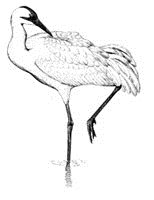North American Crane Working Group

Proceedings of the North American Crane Workshop
Date of this Version
2023
Document Type
Article
Citation
Proceedings of the North American Crane Workshop (2023) 16: 14–34
Abstract
The Sacramento–San Joaquin Delta region of California is an important wintering region for sympatric greater (Grus canadensis tabida) and lesser (G. c. canadensis) sandhill cranes. Basic information about sandhill crane use of habitats in their winter landscape is needed to design a biologically driven conservation strategy. We monitored a sample of radio-tagged birds of each subspecies for 2 winters and conducted foraging counts to document their habitat use. Cranes used the major crops and habitat types that were available in the landscapes surrounding their roost sites and focused most of their foraging in grain crops. We examined habitat selection surrounding 3 roost site complexes. In these complexes, cranes responded to agricultural practices in grain fields by generally avoiding dry corn (Zea mays) stubble, selecting both conventional and organic dry rice (Oryza sativa) stubble early in the season, and rarely using dry wild rice (Zizania palustris) stubble. Tilled fields were also usually avoided but were occasionally used shortly after tillage. Mulched corn ranked high in comparison to other corn treatments while mulched rice use was similar to dry rice stubble. Both subspecies often showed high selection of cropland habitats when they were initially flooded but use declined thereafter. Cranes were attracted to new plantings of pasture and winter wheat/triticale. One important difference between the subspecies was that lessers used alfalfa (Medicago sativa) but greaters generally avoided it. Dry corn stubble was avoided while dry rice stubble was favored early in winter by both subspecies. If wildlife managers want to favor winter field use by cranes, they could provide incentives for favorable practices such as production of grain crops, reduction or delaying tillage and flooding of grain fields, provision of irrigations to some crop types, and increasing the practice of mulching of corn stubble.


Comments
United States government work